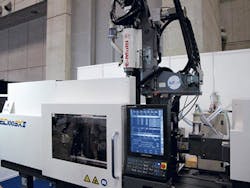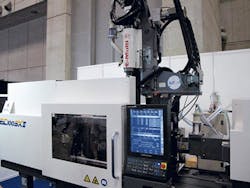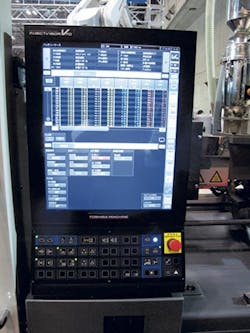A new smart factory software product from Toshiba monitors and controls automated injection molding cells and provides the means for preventive maintenance of machinery and devices.IoT+m, short for Internet of Things plus manufacturing, monitors, controls and communicates with a wide range of devices in an injection molding cell, remotely if required, said Michael Werner, senior technical key account manager for the plastics machinery division of Toshiba Machine Co. America.
The company demonstrated the software in October during the Internation Plastic Fair (IPF) in Tokyo. The setup included an injection molding cell designed to switch production automatically from one part to another, including exchanging the molds and switching from one resin to another. The cell also allowed for the end-of-arm tooling (EOAT) on a robot to be swapped out; if required, even the knockout patterns on the injection platen could be adjusted.
"Every aspect of the molding process and the production cycle is monitored. This [IoT+m] concept is a way to show Industry 4.0 or the smart factory as a tool for efficient manufacturing," Werner said.
Typically, data collected by a system designed for Industry 4.0, IoT or smart factory connectivity provides an injection molder with insight regarding the performance and impending failure of a device. This allows the molder to schedule maintenance, eliminating unscheduled downtime.
Data collected from a network of physical devices can be transmitted to a manufacturing execution system (MES) as part of a plantwide evaluation of machines for production and process efficiency, or uploaded to an enterprise resource planning (ERP) program for inventory management. Preventive maintenance is a primary benefit of a system with which devices can communicate with each other, Werner said.
COMMUNICATION HUB
The injection molding machine's controller is the communication hub for various pieces of equipment. Toshiba's IoT+m program runs on the company's new Injectvisor v70 HMI controller, which was introduced at IPF. It replaces the Injectvisor v50 controller and has increased memory, updated graphics, more customizable settings and easier-to-configure sequences. It also incorporates the Open Platform Communications-Unified Architecture (OPC-UA) industrial communications protocol, which provides a common data platform for machinery, equipment, computers and personnel, Werner said.
The Injectvisor v70 controller is standard with Toshiba's new ECSXIII line of fully electric injection presses, also introduced at IPF, Werner said. The controller can bridge the communication divide between a molder and its customer, providing the customer with the means for real-time monitoring.
An EC230SXIII injection molding machine was the center of the IoT+m molding cell, which incorporated an automatic, quick-mold-changing system and magnetic platens from Pascal Engineering Inc., Arlington Heights, Ill. The cell also had a laser etching device and an in-line QR-code reader from Keyence Corp. of America, Itasca, Ill. A Toshiba linear-arm three-axis servo robot was integrated into the molding cell for part handling. The new controller allows multi-axis robots manufactured by Toshiba's automation division to more seamlessly integrate with Toshiba's injection presses, Werner said.
The IoT+m software evaluates data relating to the condition of the mold, machine and auxiliaries. In the mold, this can include cavity pressure or cavity temperature data, mold temperature, water flow, water temperature and water pressure. Data from items like a flow meter or mold press sensor can be captured, Werner said. It also monitors machine and production data such as screw recovery time, injection pressure, clamp movement and cycle time.
A higher-end capability of IoT+m is monitoring and controlling devices that automatically change parameters when one production run ends and another begins. In the IPF demonstration, Toshiba's controller monitored the equipment during the change from a single-cavity, 142-gram interior door part to a two-cavity, 134-gram interior subcomponent, Werner said.
The machine operator can initiate the changeover in machine, tool and auxiliary parameters by pressing a button on the touch screen of the controller. Or, the molding cell can be programmed to start the changeover once it has made a required number of parts. According to Toshiba, the automated machinery cell can be prompted to execute a product change from a remote location through IoT+m.
At the show, a radio frequency identification (RFID) chip was attached to each mold set, and the parts had all machine, mold and auxiliary equipment parameters imprinted on them in the form of a laser-etched QR code. Sensing devices at the molding cell could either pick up the RFID chip code, or read the QR code to start the changeover. IoT+m monitors all actions by all equipment in the molding cell. Overall, a complete, automated changeover from one product to another was executed in a few minutes, Werner said.
CAPABILITIES TO COME
Toshiba said it is developing software features that will enhance preventive maintenance capabilities, such as the ability to predict the lifetime of the ball screw and servo amplifier. The company also is developing a function that determines the intensity of vibration of critical machinery components, and lets the user set a threshold level for alerts.
Mikell Knights, senior staff reporter
Contact:
Toshiba Machine Co. AmericaElk Grove Village, Ill., 847-709-7000, www.toshiba-machine.com


